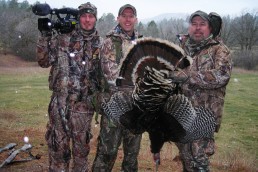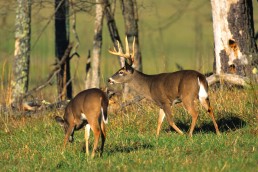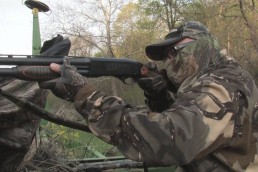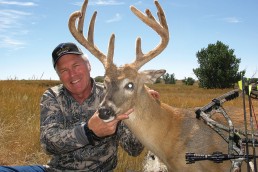Early-season Gobblers in Roller Coaster Weather
SHARE THIS POST
As I look back on all my years of turkey hunting, it seems that we get a “late” spring more often than an “early” spring. An early spring features perfect weather, perfect timing for the start of turkey season, with gobbling at its peak. So, on most years, we have to deal with less-than-ideal conditions as the turkey season gets underway.
During my 2014 spring turkey hunting marathon that featured nothing but late springs no matter where I went, tough conditions followed me from Florida to New England. I found open woods, cold wind, rain, and even snow. In more or less every state, on every hunt, turkeys were in the early phases of the mating ritual, thus rendering the old-school “soft yelp, call very little, wait 30 minutes” tactic completely useless.
Hunters pursuing springtime gobblers are programmed from years of turkey hunting lore to hen-yelp a gobbling tom within a short timeframe of the mating season.
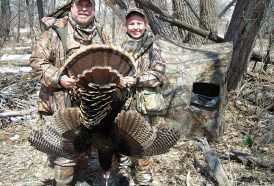
Early-season hunting prior to mating or even during mating equals plenty of hen competition for gobblers, thus making life miserable for turkey hunters who rely only on the hen yelp made to responsive, lonely, love struck toms.
Many hunters face late spring or “early season” when their state’s hunting season opens before there’s been much in the way of springtime green-up, and area gobbler flocks haven’t broken up yet, or for that matter even partially broken up. Gobblers are fighting within the flock for social status, and hen yelps are not as effective during this phase. You must be willing to change your calling to challenge a gobbler’s status within the pecking order.
Gobbler calling can work magic
Now, while it is usually tough for hunters during early season with gobblers still grouped together, it just doesn’t have to be this way! Gobbler yelping will change the game in your favor.
During this timeframe, I gobbler yelp to call and kill gobblers, and I challenge their status with aggressive yelping, purring, gobbler cutting, and even gobbling. In other words, I use my fall turkey calling skills; I call tom-to-tom with gobbler talk, and for more than 30 years, I have killed spring gobblers all across America with this tactic.
A good friction call (like a box call or a good slate or glass) is an excellent choice to duplicate gobbler yelping. Just lengthen your yelp more than hen yelps, and use a slightly slower rhythm. Don’t worry, gobblers know what it is. The reaction to challenging toms with gobbler yelping is actually pretty much the same as a hunter using modern male strutting and Jake decoys, and both are good when used in conjunction with gobbler yelping.
It’s also important to roost early season birds, get in tight, and call aggressively to challenge a gobbler’s status in the pecking order of the flock.
In between time
Early season in your hunting area may also fall at a time when gobblers are covered up with hens, but the mating ritual is not yet in full swing––so hens are paying little or no attention to gobblers. This is a time of frustration for hunters, as gobblers pay little heed to calling because they just follow hens everywhere in an attempt to impress the non-responsive ladies.
It is during this phase when a hunter has set up and called to a gobbling tom at daylight, but the hens lead him away and the hunter curses the day that gobbler was hatched.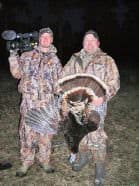
Are you enjoying this post?
You can be among the first to get the latest info on where to go, what to use and how to use it!
There are also several tactics you can implement during this phase. The first is to use the pecking order again, but this time by challenging the hens! You are not trying to call to the gobbler, but rather you call to the hens. Challenge them, call aggressively, get them calling back to you. Call however the hens call, but with more feeling and emotion.
If you can succeed in calling in a yelping, mad hen, many times the rest of the flock and gobblers will blindly follow her right up to the business end of your gun barrel.
The next tactic is to bust the flock, scatter the hens from the gobbler, either from the roost or later in the morning, then set up in the direction of the gobblers’ escape. Now call with excitement. More often than not, the gobbler will return quickly to rejoin his hens.
Actual mating time
The next phase of early spring is the actual mating process, a time when hunters hear little gobbling because toms are strutting for the girls. Roosting is very important during this time. Set up tight to the roost, be the first hen he hears at daylight, get him down, and kill him before most of the hens are even out of the roost.
Scattering flocks and gobbler yelping can also be extremely effective during this time.
In order to consistently call up turkeys, regardless of what the weather has done to your spring season, learn to look for these signs. Don’t curse the weather, don’t sit around and complain that something is wrong with the turkeys. Just be willing to adapt to whatever is happening at the moment, and you can have a great early-season hunt every year.
Now, roll the video… to watch a great early-season turkey hunting video that delves into these same topics, go to midwestoutdoors.com/earlyturkey.
Ray Eye is a MidWest Outdoors hunting instructor. He was raised in the turkey-rich hills of the Missouri Ozarks, and is considered the dean of America’s professional turkey hunters. It’s less widely known that he is an expert hunter for many other species. Eye has produced an online course, “Calling is Everything,” that details how to call turkeys at any season of the year. Find it at eyesontheoutdoors.com.
MWO
SHARE THIS POST
Did you enjoy this post?
You can be among the first to get the latest info on where to go, what to use and how to use it!
